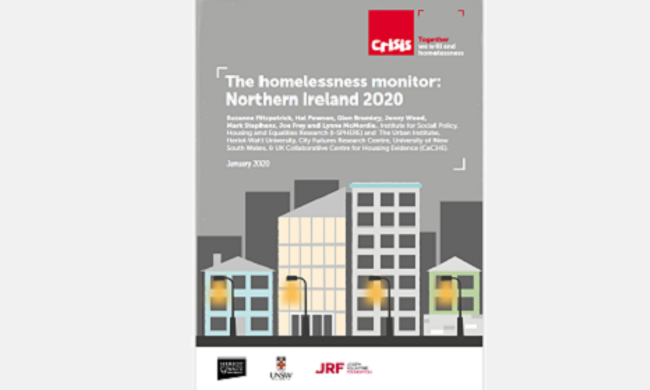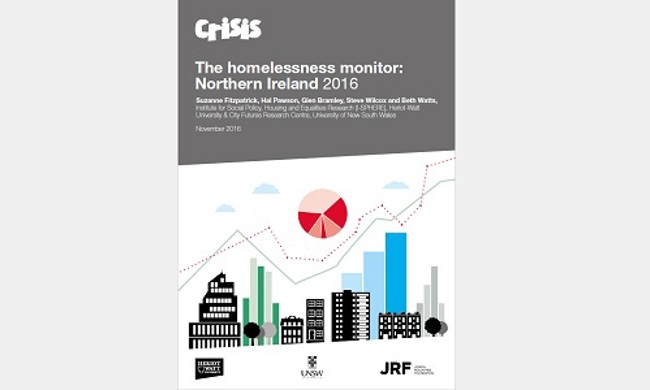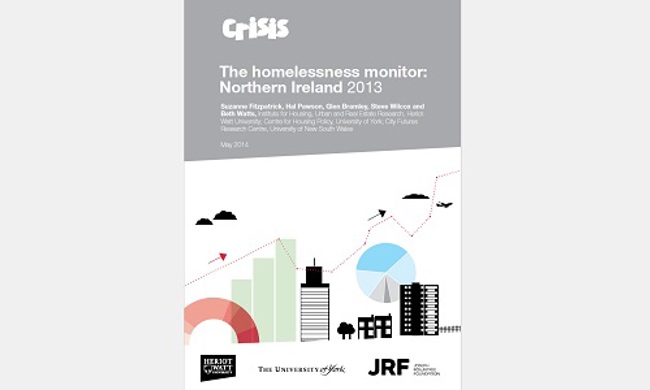The Homelessness Monitor: Northern Ireland 2020
30.01.2020
The Homelessness Monitor: Northern Ireland 2020 is the third annual report of an independent study, funded by Crisis and the Joseph Rowntree Foundation, of the homelessness impacts of recent economic and policy developments in Northern Ireland.
Key findings
- The total number of homelessness presentations in Northern Ireland has been virtually static over the past few years, but Full Duty Applicant cases have been steadily rising, increasing by 26% since 2009/10.
- There has been a perceived rise in rough sleeping in recent years. This perception is partly related to a visible increase in “street activity” including street begging and street drinking. Nevertheless, given the lack of any historical series it is difficult to judge whether rough sleeping in Northern Ireland is, in fact, changing in scale in any sustained way. Northern Ireland Housing Executive put the November 2018 number of rough sleepers across the jurisdiction at 38. Of these, 16 were in Belfast – up from only five a year earlier. Nonetheless, numbers of people rough sleeping in Northern Ireland remains relatively small in scale compared with other parts of the UK and with the Republic of Ireland.
- The overall scale of annual temporary accommodation placements has oscillated within a fairly narrow band over recent years in Northern Ireland. Nevertheless, the figure for 2017/18 was the highest of the decade, at just over 3,000.
- The roll-out of Housing Solutions and Support across Northern Ireland has generally been welcomed, with the associated enhanced data capture also felt to be an encouraging development. While the content of the Northern Ireland Housing Executive Homelessness Strategy 2017-2022 commanded general consensus, concerns remain with regard to implementation. The shift from a “rough sleeping” to a “Chronic Homelessness Action Plan” under the auspices of the Strategy received an enthusiastic reception.
- In 2017/18 lettings to homeless households accounted for no less than 88% of all Housing Executive lettings to new tenants, as compared with 39% of all social lets to new tenants in Scotland, and only 21% of all local authority lets to new tenants in England
- However, lettings by social landlords have been on a downward trajectory for some time, whilst the number of applicants in housing stress has risen. This suggests that the supply of social rented housing is one of the main pressure points in the Northern Irish housing system, and this is further evidenced by the frequency with which private tenants cite the length of social landlord waiting lists as a reason for opting for private renting.
- The private rented sector has grown enormously over the past 20 years and is now a similar size to the social rented sector in Northern Ireland. Its growth has moderated in recent years. There is little evidence of “no fault” evictions rising to anything like the extent that has occurred in England in recent years, and the loss of rented accommodation is cited as a reason for homelessness acceptances in only a relatively modest proportion of total Full Duty Applicant cases (13%).
In 2018 all Local Housing Allowance (LHA) rates fell below the 30th percentile, and in no broad rental market area (BRMA) were more than 27% of properties advertised at below the LHA rate with many tenants reporting that Housing Benefit did not cover the cost of rent. - The Welfare Reform “mitigation” package introduced in stages in 2016 and 2017 has succeeded in protecting many low-income households, especially social sector tenants, from significant reductions in their benefits. However, this protection is due to come to an end in March 2020.
- The Homelessness Monitor Northern Ireland 2020 has been published at a moment of change as the Assembly and Executive returns after a three year hiatus to take responsibility for driving key social and economic policies and programmes, and the impact of the UK’s exit from the European Union becomes clearer. Whilst currently uncertain, the impact on homelessness, if any, will need to be considered as part of any discussion about tackling and ending homelessness.
Reference
Fitzpatrick, S., Pawson, H., Bramely, G., Wood, J., Stephens, M., Frey, J. & McMordie, L (2020) The Homelessness Monitor: Northern Ireland 2020. London: Crisis.



